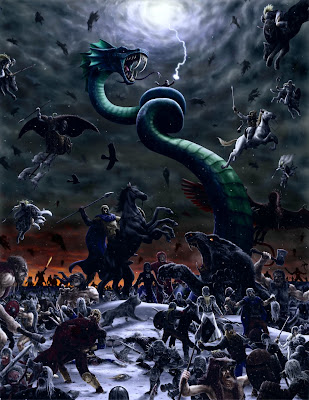The Aborigines are the ancient denizens of the Australian continent to the Southeast, believed to have migrated from the African contine
nt to Asia 70,000 years ago, and from Asia to Australia 50,000 years ago. Australia's diversified climates and unique plants and animals have given rise to a fascinating set of beliefs and stories told and retold through song and dance. Even today, some of the small remaining number of Aborigines in Australia still hold true to their ancestry and beliefs.
 |
| The Rainbow Serpent in Aboriginal Art |
Aboriginal mythology follows patterns of "animism": the attribution of souls to plants, inanimate objects, and natural phenomena. Similar to the North American Indians, the Aborigines saw that each individual object or essence had a life of some sort, whether it be a rock, a man, an animal, a tree, or a storm. This is wholly different from many proto-Christian European mythologies which focused more on gods and man's subservience to them. That is not to say the the Aborigines did not have a pantheon. However, the ancient Australians were divided by regions and developed clans, each of which practiced slightly different religions: there was not a firmly established class of deities among all people.
Contrary to Norse myth whose greatest aspect is arguably the foretelling of
Ragnarok or the end of the world, the mythology of the Aborigines is focused on the time of creation. Called the
Dreamtime, according to myth, this era was characterized by a flat earth inhabited only the spirits of all things (in some stories, it was inhabited only by people). Then, a Rainbow Serpent (a
 |
The kangaroo is a dominant
figure in Aboriginal myth |
prevailing figure in Aboriginal mythology) traverses the land (in some stories, he is looking for his lost people) and his massive body carves out valleys, ridges, and mountains as he slithers across the land. From then many events ensue which give the wandering souls of all things a physical form. In many songs and tales, the stories of creation are recounted. Stories like how the kangaroo got its pouch or its long tail, or why the raven is black offer explanations for phenomena which were said to have originated during the Dreamtime.
Other accounts of this era of creation can be found in the Songlines of the Aboriginal peoples, retellings of the paths taken by the beings of creation (such as the Rainbow Serpent). For example, in one Dreaming—or story of creation specific to a certain tribe or person—the man "Tjilbruke" had to carry his deceased nephew to the modern-day Gulf of St. Vincent. As he walked and cried for his nephew, his tears created natural springs in the earth. By reciting this story through songs (called Songlines),
 |
An Aborigine playing a "Didgeridoo," an instrument
used in the telling of Dreamings or stories of creation |
the Aborigines developed effective ways of memorizing and navigating ancient Australia by its natural landmarks (such as these springs), in some cases for over hundreds of kilometers.













